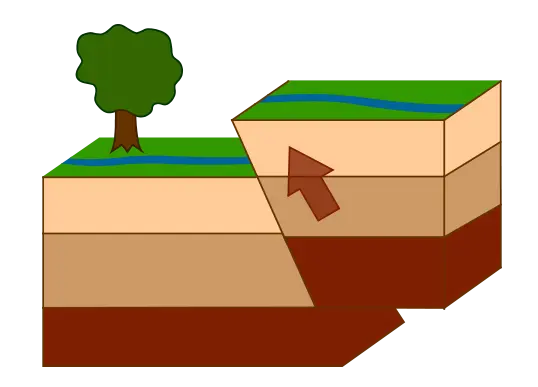GEOL 102 Earthquakes and Map
1/39
There's no tags or description
Looks like no tags are added yet.
Name | Mastery | Learn | Test | Matching | Spaced |
|---|
No study sessions yet.
40 Terms
Epicenter
location on the Earth's surface directly above the focus
Fault Surface
Fracture surface between one block and another along which movement occurs
Focus
Origin of the earthquake. The point within the Earth's crust where movement first occurred
Seismic Waves
Waves of energy that travel like shock waves from the focus to the surrounding area
P-wave
Primary / Compression wave. Like a slinky toy. Goes through both liquid and solid (pass)
S-wave
Secondary / Shear wave. Slower. Only pass through solids. Make a shadow zone on the other side of earth. Both horizontal and vertical, can cause a lot of damage.
Strike-slip Fault
Pulls in opposite directions along a plane. Shearing tension.
Normal Fault
Divergent plate boundary, tension, pulling away from each other.
Thrust Fault
Low angle reverse faults. Compression. Expected at convergent plate boundaries.
Reverse Fault
Compression, convergent plate boundary

Seisometer
Instrument that detects seismic waves and records on a paper known as seismogram
Moment Magnitude Scale
Way we measure earthquakes. Used by seismologists, quantitative. More accurate for large earthquakes. Based on energy released.
Richter Scale
Oldest and best known, quantitative scale for measuring earthquake magnitude. Calculated based on difference between P and S wave arrival times.
Natural events that cause Earthquakes
Creation of a new fault, movement along an old fault, movement of magma below the surface or volcanic explosion, landslide
Human made causes of Earthquakes
Underground nuclear explosive tests, fracking, wastewater injection
Elastic Rebound Theory
Energy is stored in the form of elastically deformed rock. When strain exceeds rock strength, the rock fractures and energy is released. Stress, strain, rupture.
Rarefractipn
"bending" of the seismic waves as they move from one material to another of different density.
Moho (Mohorovicic Discontinuity)
Boundary between crust and mantle due to a change in density and composition between the crust and mantle.
Surface Waves
Love waves and Rayleigh waves
Love Waves
Causse horizontal shifting at the surface of the earth
Rayleigh wave
Rotating waves along the surfaces, create vertical displacement, like ripples
Earthquakes at Divergent Boundaries
Shallow within ocean basins. Foci are along mid ocean ridges and transform faults
Earthquakes at Transform Fault
Shallow, and can be very destructive
Earthquakes at Convergent Boundaries
Largest earthquakes occur at subduction zones. Wadati-Benioff Zone. Shallow to deef foci.
Earthquakes at Continent-Continent Convergent Boundary
Generally shallow. Plates collide causing folding and faulting. Creating mountains
Hazards of Earthquakes
Faulting and shaking, landslides, liquefaction, tsunamis, fires.
Liquefaction
Water-saturated sediment behave like fluid. Friction decreases as water moves between particles
Longitude
0 to 180 East or West
Latitude
0 to 90 North or South
Relief
Location where there is a difference in elevation
Hachure contour lines
Show depression
True North (Geographic north)
Direction to the north pole of the Earth, the top of the sphere, where all lines of longitude converge.
Grid North
North used in the grid system (slightly misalignes)
Magnetic North
Direction of north defined by Earth's magnetic field. Constantly moves
Magnetic Field
Extends from the outer core of the Earth into space, creating magnetosphere. It is caused by currents f electricity that flow in the liquid outer core.
Magnetic Declination
Difference in degrees between true north and magnetic north
Lithosphere
Crust and upper most solid mantle, rigid
Mantle
Upper Mantle, asthenosphere, lower mantle; Plastic
Core
Outer is liquid, inner is solid. Mostly Iron
Ring of Fire
Most seismically and volcanically active zone in the world